AMD Radeon HD 5670 vs. NVIDIA GeForce GT240

Dear Habro readers, below I published a literary translation of an article by a good friend of OCClub.ru , a famous Romanian IT journalist and overclocking monstructor , one of the founders of the LAB501 project. I decided to share this material with you for a reason - I really liked the style of analytics (in IT, unfortunately, there is very little journalism in general, and this is just such a “hot” sample :)), and the topic is very, very relevant. I invite you too to evaluate the work of my colleague!
Attention! Under the cut - quite a lot of photos.
')
Introduction
Much has been written about cool, powerful, tasty, especially from the point of view of overclockers and gamers, maniacs, and the most expensive dual-chip AMD Radeon HD 5970, but today we will discuss, on the contrary, the cheapest (at the moment) video card in the Radeon HD line 5xxx codenamed Redwood (mahogany) AMD Radeon HD 5670 , which can be a "ray of light" for users who do not have abnormal budgets. Honestly, you have a strange feeling when, when you open the box, face to face with a sound card with a DVI output, especially if you had only dealt with top products before. You don't feel any better, and when you come across her quiet "girlfriend" from HIS - a network card with cooling in the style of "Batman-on-steroids". Usually, I avoided meeting with such “works of jewelry art”, but I must admit that now, in times of economic recession, these babes will be interesting to many readers who prefer video cards at a price of around $ 100. So I had enough patience, stuck a “sound card” into the test bench, put on the Batman ears, and sat down at the tests to find out if it was possible to play on it somehow? Am I right in my skepticism or am I mistaken? Well, it will be seen later.
But not earlier than I say a few words about what is happening :). The situation on the market of graphics cards is now, frankly, interesting, unique, and even unexpected. AMD was the first to release the powerful 5th series, which not only introduced support for DirectX 11 , but also has enormous computing power, and this applies to video cards of all price segments. HD 5970, HD 5870, HD 5850, HD 5770 and HD 5750 are simply trendsetters in the current market, while NVIDIA is all engaged in “enriching” its range with PhysX, CUDA, 3D Vision technologies, but not new products. AMD video cards dominate the entire range, but face problems of availability and efficiency of use, while NVIDIA is waving a “future technology” in front of us - Tesla, three-dimensional image, 40-nanometer process technology and renaming old products ... GT 240, GTS 240 ... Who are they Figs are needed? Give us a GT300 and a point, instead of releasing old "new" products for 7-8 months already!
Honestly, I don’t like NVIDIA’s marketing policy at all last year. Well, well, I am ready to forgive them for this, but the painful delay in launching a new generation of their graphic chips has affected all of us, whether we realize it or not. Because of this, AMD, whose key sales, until recently, were based on providing the best combination of "price-quality", dramatically shaken up the price lists, and now we have more stringent prices for cheaper products. Until you catch the meaning in my words? Well, let's not beat around the bush ... To put it simply, the video card, which now stands, like HD 4770 at the time of the start of sales, is replacing HD 4650 - feel the irony! The lack of a real reaction from a competitor hit the market segment, where 7 bucks is still a freaking difference!
I had not dealt with the average level for too long, so I became overly optimistic. Well, now only on what kind of performance the novelty shows, depends on whether I change my attitude to it or not.
Product introduction
For testing, I received from HIS a reference version of the AMD Radeon HD 5670 and a proprietary model with Arctic Cooling dual-slot cooling system Ice-Q. We investigate the retail version of HIS, which should soon appear in stores. The package contains the video card itself, a driver CD and a user manual. It is quite enough if we consider that we are dealing with an entry-level product, albeit with non-reference cooling.
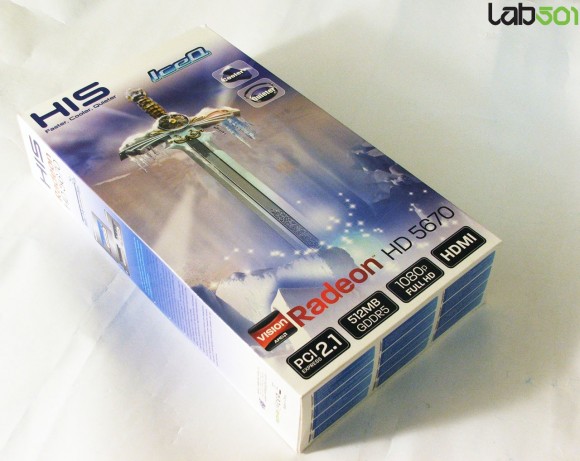

The decision from HIS made me soften my opinion a little - the card looks quite good. When a video card is cooled down, the system is significantly larger in size than on the reference model, for me it starts to look like a small diamond.
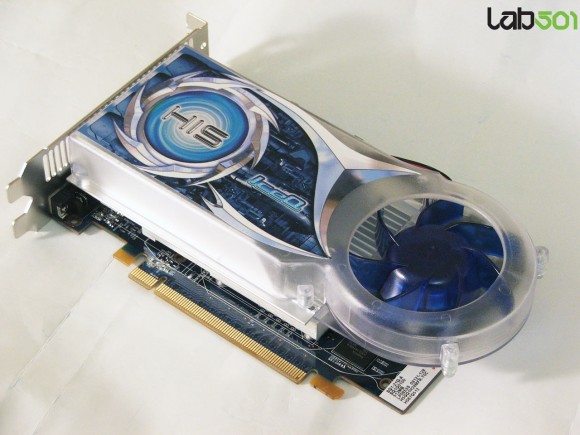
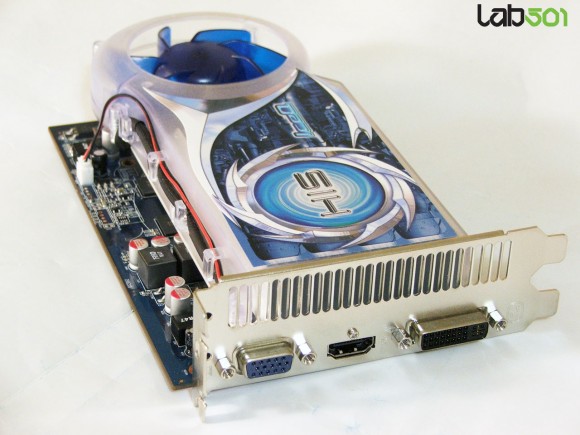
The connectors are diverse (D-SUB, DVI and HDMI) and cover the whole range of interfaces used now.
The cooling system takes up two slots and ejects hot air outside the PC case. This is a definite plus, which can not be said about the reference AMD Radeon HD 5670, which will fry about the first! In addition, the 80mm fan at lower revs allows you to keep the chipset cooler, which makes this product very quiet, and you can't help but recognize that this is quite impressive for a product from this price range.
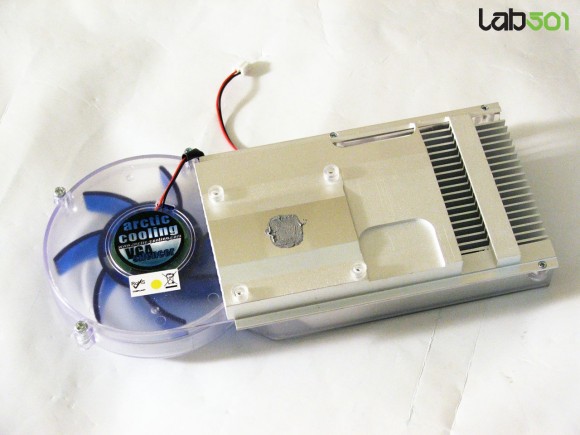
The radiator used in the cooling system from Arctic Cooling is completely made of aluminum. It has a fair distance between the ribs, which allows this sample to achieve low temperatures with a rather low air flow. The only drawback of a non-reference radiator is the lack of direct contact with memory chips, but, as shown by stability tests, they are not prone to overheating, so in practice this is not so important.
Reference Card Comparison
We did not have the opportunity to test the reference version of the retail video card (and something tells me that we will see more variants of AMD / ATI reference models provided as the first engineering samples for testing), but it is obvious that it will have a small the cooler is objectively louder than the HIS solution, and black PCB (it is dark blue in HIS), but, with the exception of configuration engineering switches and output ports, the boards will be identical.


As I said about comparing the output ports, the HIS on the card shows D-SUB, DVI and HDMI, while AMD's engineering sample implements VDI, HDMI and Display Port. The absence of D-SUB in this price segment seems illogical, but most likely this is due to the fact that AMD wanted to show that even the tiny HD 5670 can use Eyefinity technology.

I think the most attentive readers have already noticed that something is missing here. Honestly, this is generally the first thing that I was looking for with my eyes while sitting at the presentation - yeah, talking about the CrossFire connector. Yes, yes, ladies and gentlemen, despite the fact that I carefully examined all three reference samples at the presentation, I haven’t found anything like this on one of them. This unfortunately limits the use of AMD Radeon HD 5670 in the CrossFire array to only two video cards combined by the motherboard. Despite the fact that I was very curious to find out how three such "animals" would behave in CrossFireX, it is impossible to know this physically.

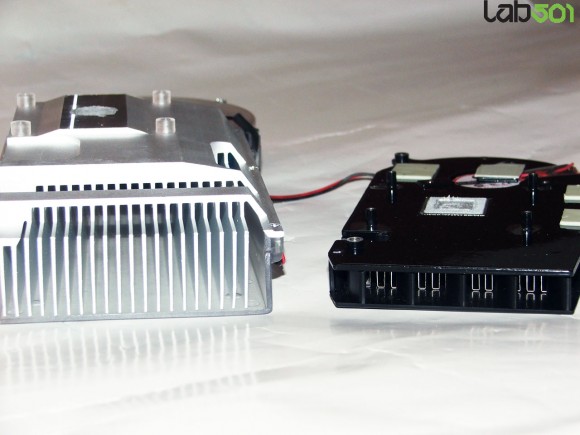
Considering the cooling systems, it is easy to assume that very soon we will see fanless solutions that are ideal for HTPC fans.
Under the hood
Well, now, when we twisted the video cards and looked at them from all sides, let's do what I like, and the readers like the most - undress :). I "bare" both vidushki - HIS and AMD Radeon HD 5670.
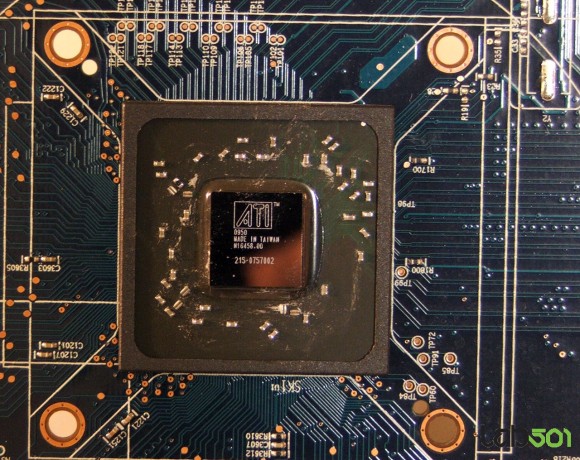

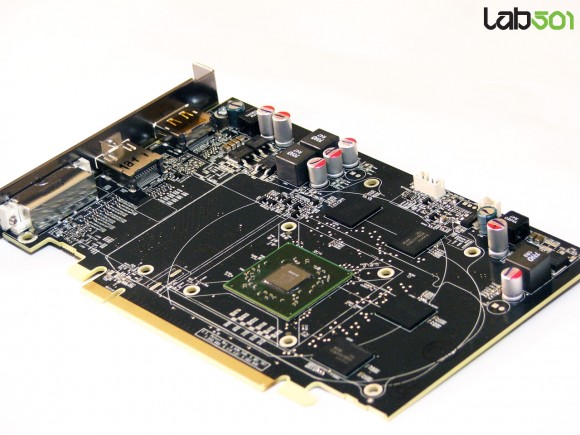
The board is as simple as possible, which makes it look like a HD 4770. A two-phase power supply for the GPU and one phase for powering the GDDR5 is enough for a small red tree. Memory chips are released by Hynix and certified to operate at 1 GHz (4 GHz effective QDR frequency). Note the lack of CrossFire contacts in the presented photos. However, as I said earlier, you can use software CrossFire from two cards that communicate only via the motherboard bus.
Specs
AMD Radeon HD 5670 belongs to the 5th series of AMD video cards, so we have support for DirectX 11, 40nm manufacturing process and GDDR5 memory. The width of the memory bus is maintained at 128 bit, as in the HD 57xx, and the number of stream processors is reduced to 400 (by half compared to the HD 57xx). For comparison, the AMD Radeon HD 4770 has 640 stream processors, but only supports DirectX 10.1. The performance of the processor at 620 Gflops also tells us that we are not dealing with weak graphics, but we will condemn this after practical tests. Another thing to mention is that the HD 5670 is a card that costs less than $ 100 and is capable of streaming HD content (video and audio) via an HDMI cable without any problems.
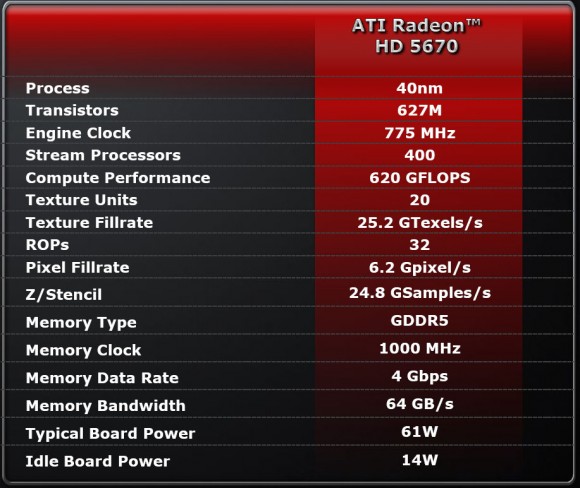


Eyefinity, HDMI 1.3a with Dolby True HD support and DTS Master Audio - indicate AMD in their presentation. I draw your attention to the critical aspects: ~ $ 100, ~ 61W. “Fair low price, very economical” - I would describe this video card if I had to do it in a short SMS.
Test platform
For the AMD Radeon HD 5670 test, I will use the platform that I previously used for the Gigabyte GeForce GT240 test. Why? And to understand how these two new products are positioned relative to each other. I do this for clarity of information - not for direct comparison. To remove all the bottlenecks from the platform, I used an Intel Core i7 870 overclocked to 4 GHz, 4 GB DDR3 2000 CL9 Avexir, an EVGA Classified P55 NF200 based High-End motherboard. However, it is obvious that happy buyers of HD 5670 are clearly not in the category of buyers “Classified + i870”, so I used the second test platform consisting of Biostar TH55 XE, Core i3 530 at the nominal frequency (2.93 GHz) and 4 GB DDR3 1333 CL9. In other words, an inexpensive but powerful platform. I also wanted to test the E4300 + DFI Infinity P965-S + 2GB DDR2, but Windows 7 with the 965th DFI chipset and HD 5670 refused to be friends, therefore, due to some lack of time, I had to give up on this idea.
Test bench:
CPU:
1) Intel Core i7 870 @ 4 GHz
2) Intel Core i3 530 @ 2.93 GHz
Motherboard:
1) EVGA Classified P55 NF200
2) Biostar TH55 XE
RAM:
2x2 GB DDR3 2000 MHz Avexir
1) 2000 MHz 9-9-9-24 1T
2) 1333 MHz 9-9-9-24 1T
Cooling: Noctua NH-U12P + Coolink SWIF 2 120P 1950 rpm
Video card:
1) Gigabyte GeForce GT240
2) HIS Radeon HD 5670
3) AMD Radeon HD 5670
Hard Drive: WD 5000AAKS
Power supply: OCZ EliteXStream 1000W
Ambient temperature: + 25 ° C
OS: Windows 7 Ultimate x86
Drivers:
1) NVIDIA Forceware 195.62 WHQL
2) ATI BETA 8.14.10.0708
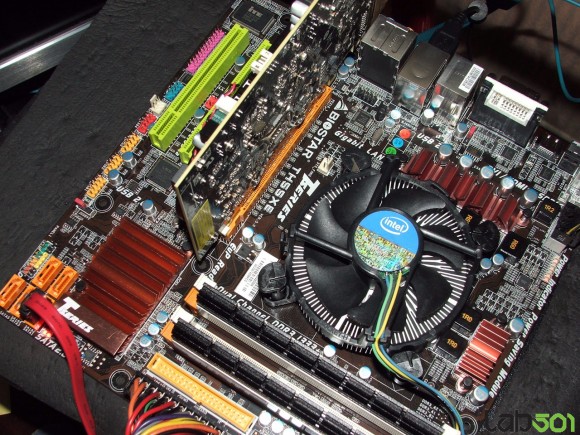
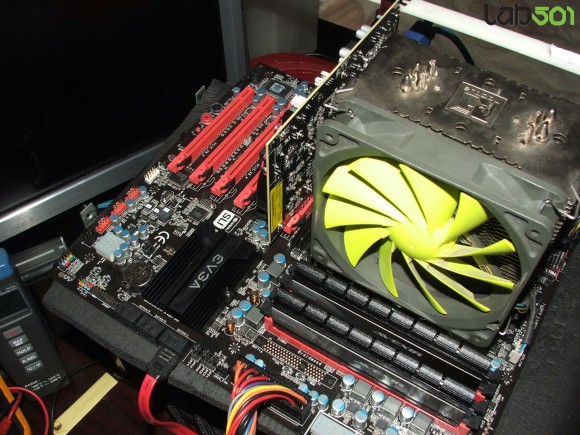
Testing method
There was little time. I could, of course, perform comparative testing with HD 4770, but instead I decided to run both cards one at a time and in the CrossFire configuration and see the performance of a single card on different processors. I did not run the 3DMark set for the Intel Core i3 530 processor - the processor’s effect on these tests is well known. Instead, I wanted to see results in real applications of a 2-core processor with 4 threads at 2.93 GHz versus a more powerful Lynnfield with 4 cores and 8 threads at 4 GHz in combination with an entry-level video card. Also, the difference in memory settings was gigantic (DDR3 2000 MHz CL9 versus DDR3 1333 MHz CL9), which made it possible to finally answer the question whether it makes sense to spend money on “with requests” for systems of this performance level.
Specifications:
| Graphics chip | HD 5670 | GT240 |
| Chip name | Redwood | GT215 |
| GPU frequency | 775 MHz | 550 MHz |
| Memory frequency | 1000 MHz | 950 MHz |
| Shader frequency | 775 MHz | 1340 MHz |
| GDDR volume | 512 MB | 512 MB |
| Memory type | GDDR5 | GDDR5 |
| Memory bus width | 128 bits | 128 bits |
| The number of shader processors | 400 | 96 |
| Texture Blocks (ROP) | eight | eight |
| Technological process | 40nm | 40nm |
| GPU frequency (overclocking) | 850 MHz | 615 MHz |
| Memory frequency (overclocking) | 1000 MHz | 950 MHz |
| Shnider frequency (overclocking) | 850 MHz | 1500 MHz |
At prices, the novelty from AMD goes head to head with a Gigabyte GeForce GT240, equipped with 512 MB of GDDR5 (~ $ 100). This is the latest NVIDIA product launched in the entry-level segment, produced using a 40nm process technology and bringing support for DirectX 10.1. The Gigabyte version is also in the “Batman-style”, as you can see from the photo.
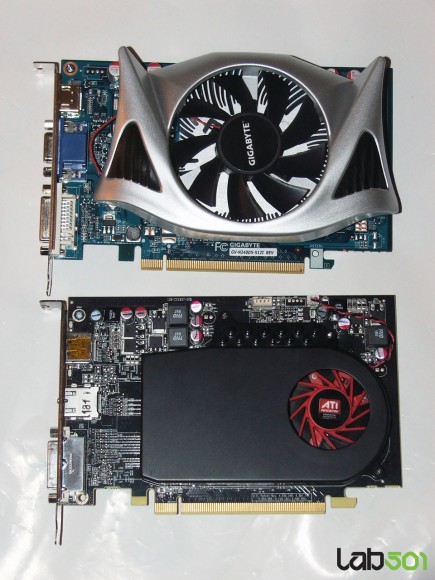
Testing
As always, we start with synthetic tests to determine the "gross" performance of the tested video cards.
3DMark 2003
Hd 5670 immediately broke away from the GT240, and the gap is very significant for this level of performance. CrossFire has achieved significant performance gains, although the gains have not been able to overcome 50% of the performance of a single video card.

3DMark 2005
The situation remained unchanged in 3DMark 2005, but the advance of the HD 5670 of the rival GT240 is significantly less than in the previous benchmark.

3DMark 2006
The difference in the performance of video cards of competitors remained at the same level in 3DMark 2006, but unexpectedly surprised CrossFire, who managed to impress us with ~ 90% growth. It seems that the latest graphics technologies have managed to increase the benefits of adding a second video card to a computer.
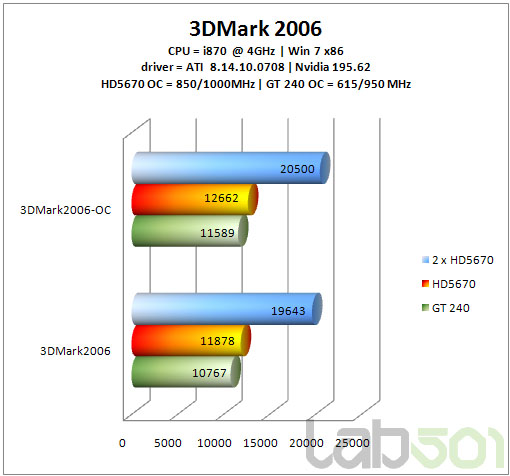
3DMark Vantage
And Vantage also notes an increase in the gain from the second video card, while the difference between the GT240 and HD 5670 remains unshakable.
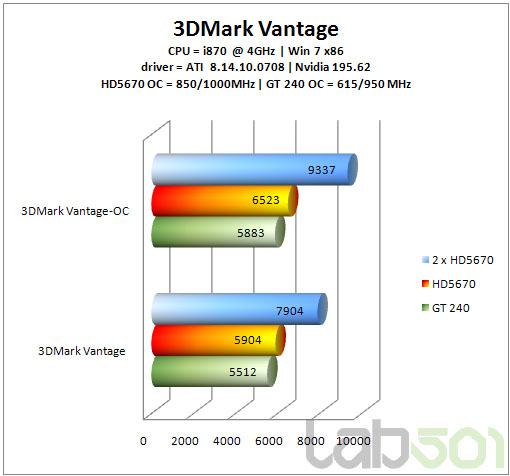
Game Tests
This time the games are a really interesting agenda item even for me: it was always curious to see what these “Dwarfs from 3D” can do . The choice of settings this time required a great deal of delicacy and serious preliminary tests to select the optimal settings for each game. Finally, I decided to stay at a resolution of 1680 x 1050 with two levels of detail, where it was possible. Thus, I tried to choose a number of settings that brought the results to the playable level, because, in the end, these video cards in large quantities will not be bought by benchmarking monsters, but by users who just want to play.
Farcry2
Well, who would doubt that we will start with FarCry2 - Duna is still one of the most advanced graphics engines at the moment. Unfortunately, it was not possible to choose two levels of detail in the DX10 mode - any increase in them led to the blocking of test results or to too low frame rate values. Thus, presets for DX10 with all settings in Hihg mode without anti-aliasing (anti-aliasing) were used. Fire, physics and trees were set low, and textures were set to medium. Any attempt to run a test with these settings on Hihg resulted in a test crash. This is probably a driver problem that even occurs with performance limiting settings.

It immediately catches the eye that the difference between competing video cards is scanty. Yes, 3-4 frames per second - at 45 fps, about 8-10%, but at this level, this difference does not affect the normal gameplay. Much more interesting is the monstrous increase that CrossFire has provided, so adding a second video card can significantly change the gaming experience.
And finally, but this is no less interesting to compare the two platforms Core i3 530 at 2.93 GHz and Core i7 870 at 4 GHz, and the difference between them ... is zero!
Tom Clancy's HAWX
Thanks to the implementation of DX10.1, HAWX has always been a very interesting benchmark, and AMD graphics cards took precedence on this issue. Well, now NVIDIA graphics cards also support DX 10.1, so I was very interested in what we get as a result. In HAWX (as in other games, with the exception of FarCry2) I was able to use two levels of quality settings at a resolution of 1680 x 1050. Thus, the first time I drove the benchmark with high details and double anti-aliasing (AA x2), and the second with less detailing (low / medium) and disabled anti-aliasing. When using the settings pen, the difference between AMD and NVIDIA is quite large, but it is practically insignificant when you run the test in low detail. Again there is a monstrous increase in the use of CrossFire, but no difference between the two platforms.

Resident evil 5
Resident Evil 5 keeps on flowing: ~ 10% of the difference between AMD and NVIDIA, while the multi-card configuration "shoots" for 50% (except for high detail mode with anti-aliasing, where even it stumbles). Again (yes, I know, I repeat) no difference between the Core i3 in stock and the overclocked Core i7.
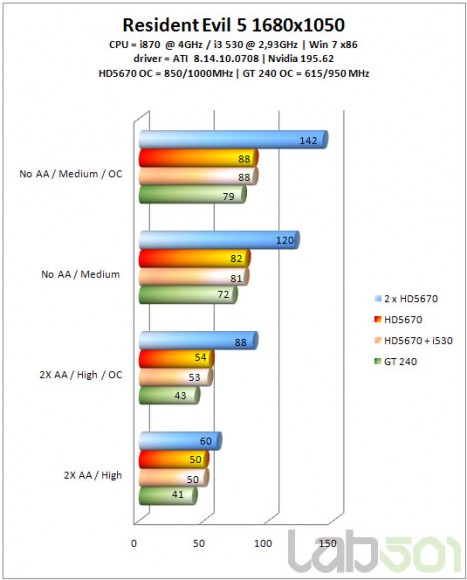
STALKER: Call of Pripyat
Call of Pripyat is one of the first games using DX11, providing the user with exciting visual experiences. Interestingly, Call of Pripyat is the only game where the GT240 celebrated a victory. At high settings, the GT240 manages to ride farther than the HD 5670, but at low details the performance is again the same. And it’s already quite entertaining that both video cards get about the same results in the first three tests (Day, Night, Rain, Sunshafts) and have some sickly problems in the 4th, where HD 5670 gains 1.5 fps and GT240 - 5 fps.
The gain in CrossFire is slightly smaller - about 30%, and the difference between the stock Core i3 and the overclocked Core i7, obviously, does not exist.

Temperature
I must say that from the very beginning of testing until its completion, there were no problems with the devices reached by the temperature during the tests. The AMD reference card reached 69 ° C at 39% fan speed during acceleration and 67 ° C at typical settings and a fan by 38%. The model from HIS behaved in a similar way, reaching 70 ° C with 39% of the cooler's work during the overclock and 68 ° C at 37% of the maximum speed with standard settings. Obviously, the fundamental difference between the two solutions is in the noise level, which is significantly lower in HIS. GT240 is also not out of the general trend, showing 72 ° C with 35% of the cooler, demonstrating a very low noise level, thanks to the non-reference cooling system from Gigabyte. Even though I laughed at him at the beginning, Batman does his job very well!
Obviously, with such power consumption (61W) the HD 5670 is great for HTPCs and fans of silent computers. Of course, fanless solutions will not be long in coming and will allow you to gain complete silence.
Effect of used CPU
Even though I couldn’t test everything that was supposed to be originally (even a weaker processor - Intel Core 2 Duo E4300), I was able to compare two platforms: Intel Core i3 530 + DDR3 1333 MHz CL9 and Intel Core i7 870 + DDR3 2000 MHz CL9 - and the results are inspiring. If the budget does not allow you to buy a powerful graphics solution, then the processor will not affect the performance in any way, for example, HD 5670 - the system is limited by the processing power and not the CPU frequency, as is the case with more expensive video cards. Thus, you can save a significant amount by purchasing a relatively cheap platform based on Core i3 and a video card from the latest AMD Radeom 5-series line. In other words, a system that allows you to play at a resolution of 1680 x 1050 with medium detail settings, capable of playing full HD video and having an acceptable level of noise, can be purchased for as little as $ 700. Personally, I think this is a very good buy. It is worth noting that, obviously, the influence of the processor will be higher if you run games in a lower resolution, but in this case, the meaning of purchasing a video card with DX 11 support is not very clear.
findings
So, we got to the end of our adventure with 3D gnomes, and it's time to draw a line. What do you think, to remain in the position voiced at the very beginning of the material? Or recognize the success of HD 5670? My personal opinion - it all depends on the price. The closer it is to $ 100, the more confidently we can say that the HD 5670 is worth its money and has advantages over the offers of competitors in the same price category. The news is encouraging - the first installments received by online stores are sold at a price in the range of 112-119 dollars. The specific product that is definitely noteworthy is the HIS HD 5670 because, in my opinion, the Arctic Cooling Silencer cooling system gives it some added value at the same price and provides a decent level of noise. We may see similar solutions from other manufacturers, but so far only HIS has declared its readiness to supply its devices and is trying to keep the price at an acceptably low level.
Finally, I have to admit that the HD 5670 exceeded my expectations - gaming performance at a resolution of 1680 x 1050 is quite decent. However, for a better visual experience at this resolution, a little more power will not hurt. A little more performance and a price of around $ 95 would make this model the absolute “Best Buy” in this price segment. The solution of two HD 5670 in CrossFire is really very interesting. The problem is only in changing the pricing strategy, due to the lack of competition, with the result that HD 5670 is positioned differently than its ancestors. Thus, the focus is on DX 11, Eyefinity and HD playback, adding value to the product, while gaming performance remains at the level of the Radeon HD 4850, positioned by the manufacturer at a recommended price of $ 119. Thus, AMD offers a new level of technology with gaming performance of the old repositioned product. I personally cannot be grateful for the price increase for an X650 class product, but I have to admit that this is a more elegant solution than the constant rebranding practiced by some manufacturers.
We can conclude that AMD now has a full range of products, ranging from $ 100 to $ 770, and it won the competition for the entry-level segment. Of course, by launching our new competing product, the “green camp” will unleash a new price war, which will create the price pressure we need and will allow us to get prices better than now. Well, as long as very cheap solutions are being prepared, HD 5670 remains the cheapest product with DX 11 support on the market.
Source: https://habr.com/ru/post/81397/
All Articles